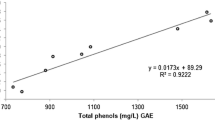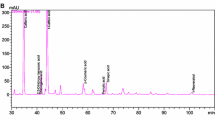Abstract
Influence of maceration on phenolic content and antiradical activity was analyzed in fourteen white wines from Italian region Friuli–Venezia Giulia and Croatian region Istria. Total phenols were determined by Folin–Ciocalteu reagent, twelve individual polyphenols were determined by high-performance liquid chromatography and antiradical activity was determined using 2,2-diphenyl-1-picrylhydrazyl free radical (DPPH·). The experiments showed that the maceration process increases significantly the amount of total phenols and inhibition of DPPH·. Furthermore, a high synergistic activity of individual phenols was observed. The strongest inhibition of DPPH· and the highest amount of total phenols were obtained for 800 Bianco, a blending macerated wine made from 3 white wine varieties. Our study shows that the antioxidant potential of white grape phenols can be preserved during wine processing. The maceration step allows the extraction of phenolic compounds from grape skins, seeds and stalks, resulting in phenol-rich white wine with strong antioxidant properties.




Similar content being viewed by others
References
Babu PVA, Liu D (2009) Flavonoids and cardiovascular health. In: Watson RR (ed) Complementary and alternative therapies and the aging population. Academic Press, San Diego
De Whalley CV, Rankin SM, Hoult JRS, Jessup W, Leake DS (1990) Flavonoids inhibit the oxidative modification of low density lipoproteins by macrophages. Biochem Pharmacol 39:743–1750
Osada K, Takahashia M, Hoshina S, Nakamura M, Nakamura S, Sugano M (2001) Tea catechins inhibit cholesterol oxidation accompanying oxidation of low density lipoprotein in vitro. Comp Biochem Physiol Part C: Toxicol Pharmacol 128:153–164
Yochum L, Kushi LH, Meyer K, Folsom AR (1999) Dietary flavonoid intake and risk of cardiovascular disease in postmenopausal women. Am J Epidemiol 149:943–949
Leifert WR, Abeywardena MY (2008) Cardioprotective actions of grape polyphenols. Nutr Res 28:729–737
Sun AY, Simonyi A, Sun GY (2002) The “French paradox” and beyond: neuroprotective effects of polyphenols. Free Radical Biol Med 32:314–318
Nigdikar SV, Williams NR, Griffin BA, Howard AN (1998) Consumption of red wine polyphenols reduces the susceptibility of low-density lipoproteins to oxidation in vivo. Am J Clin Nutr 68:258–265
Serafini M, Maiani G, Ferro-Luzzi A (1998) Alcohol-free red wine enhances plasma antioxidant capacity in humans. J Nutr 128:1003–1007
Fuhrman B, Volkova N, Suraski A, Ml Aviram (2001) White wine with red wine-like properties: increased extraction of grape skin polyphenols improves the antioxidant capacity of the derived white wine. J Agric Food Chem 49:3164–3168
Dominé A (2004/2007) Wine. Tandem Verlag GmbH, China
Škerget M, Kotnik P, Hadolin M, Rižner-Hraš A, Simonič M, Knez Ž (2005) Phenols, proanthocyanidins, flavones and flavonols in some plant materials and their antioxidant activities. Food Chem 89:191–198
Makris DP, Psarra E, Kallithraka S, Kefalas P (2003) The effect of polyphenolic composition as related to antioxidant capacity in white wines. Food Res Int 36:805–814
Majhenič L, Škerget M, Knez Ž (2007) Antioxidant and antimicrobial activity of guarana seed extracts. Food Chem 104:1258–1268
Ginjom IR, D’Arcy BR, Caffin NA, Gidley MJ (2010) Phenolic contents and antioxidant activities of major Australian red wines throughout the winemaking process. J Agric Food Chem 58:10133–10142
Lante A, Crapisi A, Lomolino G, Spettoli P (2004) Chemical parameters, biologically active polyphenols and sensory characteristics of some Italian organic wines. J Wine Res 15:203–209
Paixão N, Perestrelo R, Marques JC, Câmara JS (2007) Relationship between antioxidant capacity and total phenolic content of red, rosé and white wines. Food Chem 105:204–214
Vinković Vrček I, Bojić M, Žuntar I, Mendaš G, Medić-Šarić M (2011) Phenol content, antioxidant activity and metal composition of Croatian wines deriving from organically and conventionally grown grapes. Food Chem 124:354–361
Roussis IG, Lambropoulos I, Tzimas P, Gkoulioti A, Marinos V, Tsoupeis D, Boutaris I (2008) Antioxidant activities of some Greek wines and wine phenolic extracts. J Food Compos Anal 21:614–621
Katalinić V, Milos M, Modun D, Musić I, Boban M (2004) Antioxidant effectiveness of selected wines in comparison with (+)-catechin. Food Chem 86:593–600
Cheynier VF, Trousdale EK, Singleton VL, Salgues MJ, Wylde R (1986) Characterization of 2-S-glutathionyl caftaric acid and its hydrolysis in relation to grape wines. J Agric Food Chem 34:217–221
Fernández-Pachón MS, Villaño D, Troncoso AM, García-Parrilla MC (2006) Determination of the phenolic composition of sherry and table white wines by liquid chromatography and their relation with antioxidant activity. Anal Chim Acta 563:101–108
Hernanz D, Recamales ÁF, González-Miret ML, Gómez-Míguez MJ, Vicario IM, Heredia FJ (2007) Phenolic composition of white wines with a prefermentative maceration at experimental and industrial scale. J Food Eng 80:327–335
Kallithraka S, Tsoutsouras E, Tzourou E, Lanaridis P (2006) Principal phenolic compounds in Greek red wines. Food Chem 99:784–793
La Torre GL, Saitta M, Vilasi F, Pellicanò T, Dugo G (2006) Direct determination of phenolic compounds in Sicilian wines by liquid chromatography with PDA and MS detection. Food Chem 94:640–650
Rastija V, Srečnik G, Medić-Šarić M (2009) Polyphenolic composition of Croatian wines with different geographical origins. Food Chem 115:54–60
Buiarelli F, Coccioli F, Merolle M, Jasionowska R, Terracciano A (2010) Identification of hydroxycinnamic acid–tartaric acid esters in wine by HPLC–tandem mass spectrometry. Food Chem 123:827–833
De Souza Dias F, Ml PalmaLovillo, Garcia Barroso C, Mauricio David J (2010) Optimization and validation of a method for the direct determination of catechin and epicatechin in red wines by HPLC/fluorescence. Microchem J 96:17–20
Alén-Ruiz F, García-Falcón MS, Pérez-Lamela MC, Martínez-Carballo E, Simal-Gándara J (2009) Influence of major polyphenols on antioxidant activity in Mencía and Brancellao red wines. Food Chem 113:53–60
Author information
Authors and Affiliations
Corresponding author
Rights and permissions
About this article
Cite this article
Ružić, I., Škerget, M., Knez, Ž. et al. Phenolic content and antioxidant potential of macerated white wines. Eur Food Res Technol 233, 465–472 (2011). https://doi.org/10.1007/s00217-011-1535-4
Received:
Revised:
Accepted:
Published:
Issue Date:
DOI: https://doi.org/10.1007/s00217-011-1535-4




